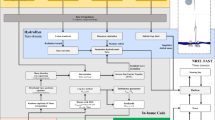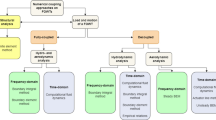Abstract
This study aims to analyze the effects of dynamic motion and structural response of semi-submersible floating offshore wind turbine structures (FOWTs) in waves generated in hurricane environments. The extreme environment utilizes numerical simulation data of hurricanes and is divided into low-frequency and high-frequency components based on wave-age, and a load case combining wind and wave is applied. As the hurricane progresses, a spectrum divided into swell and wind sea components is generated in the ocean, and the swell component is distributed in the natural frequency range of the structure, increasing the dynamic response. Dynamic analysis compares the cumulative response by fitting the response for each wave component generated by the hurricane through the Gaussian mixture model. In the structural analysis, the hydrodynamic pressure calculated through diffraction analysis is mapped to a finite element model using the quasi-dynamics interaction method, and the von Mises stress per wave component is analyzed. Through this, it is possible to grasp the main factors of the dynamic and structural responses of semi-submersible FOWTs.















Similar content being viewed by others
References
Shin, C., & Yuk, G. (2011). Environmental and economic impacts of offshore wind power. Korea Maritime Institute, pp. 1–84.
International Electrotechnical Commission. (2007). IEC 61400-1 wind turbines - part 1: design (3rd ed.).
American Petroleum Institute. (2007). Interim guidance on hurricane conditions in the Gulf of Mexico. API BULL2INT-MET (1st ed.).
Velarde, J., Vanem, E., Kramhøft, C., & Sørensen, J. D. (2019). Probabilistic analysis of offshore wind turbines under extreme resonant response: application of environmental contour method. Applied Ocean Research, 93, 101947.
Ha, K., Truong, H. V. A., Dang, T. D., & Ahn, K. K. (2021). Recent control technologies for floating offshore wind energy system: a review. International Journal of Precision Engineering and Manufacturing-Green Technology, 8, 281–301.
Zhang, L., Lu, H., Yang, J., Peng, T., & Xiao, L. (2013). Low-frequency drift forces and horizontal motions of a moored FPSO in bi-directional swell and wind-sea offshore West Africa. Ships and Offshore Structures, 8(5), 425–440.
Zhang, L., Shi, W., Karimirad, M., Michailides, C., & Jiang, Z. (2020). Second-order hydrodynamic effects on the response of three semisubmersible floating offshore wind turbines. Ocean Engineering, 207, 107371.
Kang, T.-w, & Yang, H.-i. (2019). Influence on floating offshore wind turbine structure by wave energy generated under extreme metocean conditions. Journal of the Korean Society of Manufacturing Technology Engineers, 28(6), 375–382.
Muliawan, M. J., Karimirad, M., Gao, Z., & Moan, T. (2013). Extreme responses of a combined spar-type floating wind turbine and floating wave energy converter (STC) system with survival modes. Ocean Engineering, 65, 71–82.
Ma, Y. (2014). Research on dynamic analysis for a spar type offshore floating wind turbine. Master’s Dissertation, Shanghai Jiao Tong University, Shanghai, China.
Lefebvre, S., & Collu, M. (2012). Preliminary design of a floating support structure for a 5MW offshore wind turbine. Ocean Engineering, 40, 15–26.
Roddier, D., Cermelli, C., Aubault, A., & Weinstein, A. (2010). Wind-float: a floating foundation for offshore wind turbines. Journal of Renewable and Sustainable Energy, 2(3), 033104.
Żywicki, J., Dymarski, P., Ciba, E., & Dymarski, C. (2017). Design of structure of tension leg platform for 6 MW offshore wind turbine based on fem analysis. Polish Maritime Research, 24(s1), 230–234.
Borg, M., Bredmose, H., & Hansen, A.M. (2017). Elastic deformations of floaters for offshore wind turbines: dynamic modelling and sectional load calculations. In Proceedings of the ASME 2017 36th international conference on ocean, offshore and Arctic engineering, ASME, June 25–30, Trondheim, pp. 1–10.
Chen, S. S., Price, J. F., Zhao, W., Donelan, M. A., & Walsh, E. J. (2007). The CBLAST-Hurricane program and the next-generation fully coupled atmosphere–wave–ocean models for hurricane research and prediction. Bulletin of the American Meteorological Society, 88(3), 311–318.
Chen, S. S., Zhao, W., Donelan, M. A., & Tolman, H. L. (2013). Directional wind–wave coupling in fully coupled atmosphere–wave–ocean models: results from CBLAST-Hurricane. Journal of the Atmospheric Sciences, 70(10), 3198–3215.
Kim, E., & Manuel, L. (2016). Hurricane risk assessment for offshore wind plants. Wind Engineering, 40(3), 261–269.
Hill, C., DeLuca, C., Balaji, V., Suarez, M., & da Silva, A. (2004). The architecture of the Earth system modeling framework. Computing in Science and Engineering, 6, 18–28.
Skamarock, W.C., Klemp, J.B., Dudhia, J., Gill, D.O., Barker, D.M., Duda, M.G., Huang, X.-Y., Wang, W., & Powers, J.G. (2008). A description of the advanced research WRF version 3. Technical report NCAR/TN-475+STR, National Center for Atmospheric Research, Boulder, CO.
Wallcraft, A.J., Metzger, E.J., & Carroll, S.N. (2009). Software design description for the hybrid coordinate ocean model (HYCOM) version 2.2. Technical report NRL/MR/7320–09-9166, Naval Research Laboratory, Stennis Space Center, MS.
Kim, E., & Manuel, L. (2014). Hurricane-induced loads on offshore wind turbines with considerations for nacelle yaw and blade pitch control. Wind Engineering, 38, 413–424.
Komen, G., & Hasselmann, K. (1984). On the existence of a fully developed wind-sea spectrum. Journal of Physical Oceanography, 14(8), 1271–1285.
Kang, T.-w, & Yang, H.-i. (2019). Analysis of second hydrodynamic loads effect on the mooring line response and damage equivalent fatigue by wave energy components under extreme sea condition. Journal of the Korean Society of Manufacturing Technology Engineers, 28(6), 368–374.
Kim, E. (2015). Offshore wind turbine loads under the coupled influences of wind, waves, and currents during hurricanes. Ph.D. Dissertation, Texas at Austin University, Texas. USA.
Barth, S., & Peinke, J. (2007). Intermittence and scale separation above the North Sea. In: International European wind energy conference, Milan, Italy.
Harper, B.A., Kepert, J.D., & Ginger. J.D. (2010). Guidelines for converting between various wind averaging periods in tropical cyclone conditions. Technical report WMO/TD-No.1555, World Meteorological Organization.
Hsu, S., Blanchard, B., & Yan, Z. (1999). A simplified equation for Paulson’s Ψ m (Z/L) formulation for overwater applications. Journal of Applied Meteorology, 38(5), 623–625.
Ochi, M. (2003). Hurricane generated seas (8th ed.). Elsevier.
Miche, R. (1951). Reflectivity of marine structures exposed to action of waves. In Annale Ponts et Chaussees.
Stansberg, C.T. (1998). Non-Gaussian extremes in numerically generated second-order random waves on deep water. In 8th International offshore and polar engineering conference, Montreal, Canada.
Jonkman, J.M. (2007). Dynamics modeling and loads analysis of an offshore floating wind turbine. Ph.D. Dissertation. NREL/TP-500-41958. National Renewable Energy Laboratory.
Kang, T.-w. (2020). Dynamic motion and structural response characteristics of floating offshore wind turbine structures in extreme marine environments. Ph.D. Dissertation, Hanyang University, Seoul, Korea.
Jonkman, J.M., & Buhl Jr, M.L. (2005). FAST user’s guide. NREL/EL-500-3823. National Renewable Energy Laboratory.
ANSYS Inc. (2016). ANSYS AQWA, user’s manual release 17.0. Pittsburgh, CO, USA.
Robertson, A., Jonkman, J., Masciola, M., Song, H., Goupee, A., Coulling, A., & Luan, C. (2014). Definition of semisubmersible floating system for phase II of OC4. NREL/TP-5000-60601. National Renewable Energy Laboratory.
Jonkman, J., Butterfield, S., Musial, W., & Scott, G. (2009). Definition of a 5-MW reference wind turbine for offshore system development. NREL/TP-500-38060. National Renewable Energy Laboratory.
Lee, C.H. (1995). WAMIT theory manual. Massachusetts Institute of Technology, USA.
Sébastien, G. (2016). Aerodynamic damping on a semisubmersible floating foundation for wind turbines. Energy Procedia, 94, 367–378.
Chen, J., & Hu, Z. (2018). Experimental investigation of aerodynamic effect–induced dynamic characteristics of an OC4 semi-submersible floating wind turbine. Journal of Engineering for the Maritime Environment, 232(1), 19–36.
Kim, K., Kim, H.-G., Kim, C.-J., Paek, I., Bottasso, C. L., & Campagnolo, F. (2018). Design and validation of demanded power point tracking control algorithm of wind turbine. International Journal of Precision Engineering and Manufacturing-Green Technology, 5, 387–400.
Kim, K., Kim, H.-G., & Paek, I. (2020). Application and validation of peak shaving to improve performance of a 100 kW wind turbine. International Journal of Precision Engineering and Manufacturing-Green Technology, 7, 411–421.
Det Norske Veritas. (2007). Recommended practice DNV RP-C205 environmental conditions and environmental loads. Høvik, Norway: Det Norske Veritas.
Kane, T. R., & Levinson, D. A. (1985). Dynamics, theory and applications. McGraw Hill.
Acknowledgements
This work was supported by the research fund of Hanyang University (HY-2020)
Author information
Authors and Affiliations
Corresponding author
Additional information
Publisher's Note
Springer Nature remains neutral with regard to jurisdictional claims in published maps and institutional affiliations.
Rights and permissions
About this article
Cite this article
Kang, Tw., Kim, Es. & Yang, Hi. Effects of Dynamic Motion and Structural Response of a Semi-submersible Floating Offshore Wind Turbine Structure Under Waves Generated in a Hurricane Environment. Int. J. of Precis. Eng. and Manuf.-Green Tech. 9, 537–556 (2022). https://doi.org/10.1007/s40684-021-00331-w
Received:
Revised:
Accepted:
Published:
Issue Date:
DOI: https://doi.org/10.1007/s40684-021-00331-w




